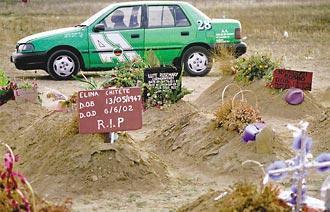JESCA DRIVES us back to the cemetery to visit Ruth's grave before we leave. It's late afternoon. Jesca hunkers down behind the wheel and declares she'll wait in the cab. "You are very brave," she says. "I'm scared to go out there."
 |
| BETTY UDESEN / THE SEATTLE TIMES |
| Harare taxi driver Jesca Machingura parks near the sign that marks Ruth's grave — Lute Rosemary — but refuses to walk among the dead. Jesca is HIV-positive and has prepaid for her own funeral so her daughter won’t have to worry. "When you know your status," she says, "you have to plan your things." |
|
 |
 |
In the marching mounds, Jesca sees her future.
The field where Ruth is buried holds 50 rows. Each row holds 50 graves, except Ruth's row, which is only three-quarters filled. Grave markers list the birth dates of the dead: 7/6/66, 3/12/75, 2/3/81, 4/8/58, 10/9/72, 11/5/95. Mostly people in their 20s, 30s and 40s, but a few younger, as young as Ireen. As young as Martha.
Standing here, where human life has stopped, it's impossible not to count time in weird ways.
A year to pilot production of an improved female condom.
Three years to debut a new diaphragm. Five years until anybody knows whether it protects against AIDS.
Five years, minimum, for a microbicide.
In five years, Ireen will be as old as Ruth was when she met Richard. Ireen's slim body will swell at the breast and hips, and her bright eyes will likely turn toward men, the spring in her step swirled by love. Can there be a vaccine by then?
In five years, Martha will have outgrown her new flowered dress, but she'll still be only 11. For her, maybe there's hope. For her, maybe the odds will be better than the 1 in 2 chance that a teen today in Zimbabwe will die of AIDS.
Faced with life's unrelenting calculus, what do you do?
Nine rows back (six months worth of deaths), the tinfoil crosses and plastic washbasins are shards.
Eighteen rows back, the grave adornments are dust. Back here, all the cemetery mounds have collapsed, the rusty dirt has tumbled down. Weeds creep, seeding the ground with pearly flowers.
If you didn't know, you probably couldn't tell that someone was buried here or that they died or that they ever lived at all.
Soon it will be dark.
Here, where the toll ticks, grave by grave, past 2.3 million, there is no gently lingering twilight, no miracle cure, no time to waste.
The sun slams down, insects buzz, a pregnant moon rises over Mabvuku's famous red earth, the damned fertile earth.